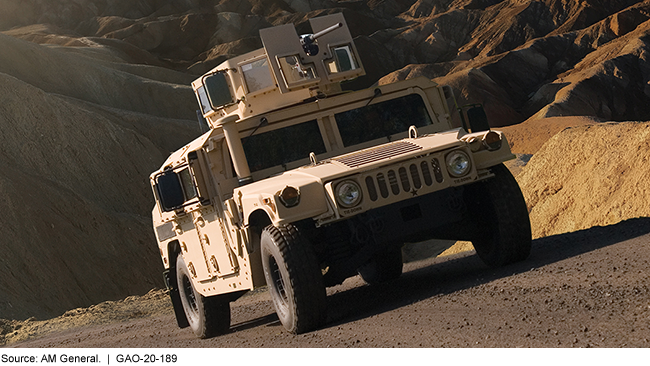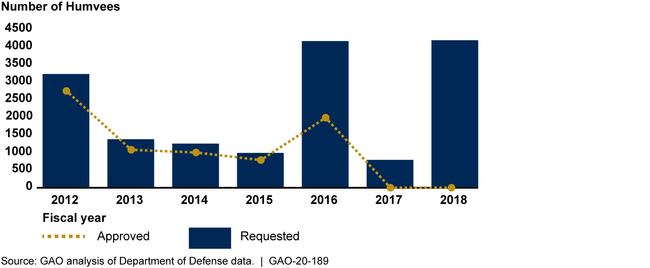Military Equipment: Observations on the Transfer of Excess Humvees to Foreign Governments
Fast Facts
Sometimes DOD determines that defense items—such as older model Humvees—are no longer needed. These vehicles are designated as excess and are made available to foreign countries upon request.
We found that 23 countries (mostly from the Middle East and Africa) requested excess Humvees from 2012-2018 to support activities like border security and counterterrorism operations. DOD approved nearly half of these requests.
The Humvee manufacturer expressed concerns that these requests might hurt its ability to sell new Humvees to these countries. However, DOD found that most of these countries could not afford to buy new Humvees.

humvee
Highlights
What GAO Found
Excess High Mobility Multipurpose Wheeled Vehicles (HMMWV)—commonly pronounced Humvees—are among thousands of items that the Department of Defense (DOD) can transfer to foreign governments at their request through the Excess Defense Articles (EDA) program. Twenty-three countries, primarily from the Middle East and Africa, requested 16,005 Humvees for the 7-year period GAO reviewed. DOD approves such requests if it determines:
excess U.S. inventory is available at the time of the request,
the request aligns with U.S. foreign policy objectives, such as using the vehicles to help combat terrorism, and
the U.S. industrial base will not be adversely affected by the transfer.
For example, DOD approved a country's request for excess Humvees for border security, counter-smuggling, and counter-terrorism efforts. DOD approved nearly half of the total Humvees requested for fiscal years 2012 through 2018 (see figure). However, DOD has halted further approvals since the start of fiscal year 2017 due to concerns expressed by the Humvee manufacturer and language in the FY 2018 National Defense Authorization Act (2018 NDAA) and conference report that generally says Humvees must be modernized at no cost to DOD.
Humvees Approved as Grants through the Foreign Assistance Act, Compared to Total Requested (by fiscal year transfer was requested)

Note: The Fiscal Year 2018 National Defense Authorization Act generally requires Humvees be modernized prior to transfer.
GAO found that DOD considered the Humvee manufacturer's perspectives on proposed transfers and generally took steps to mitigate concerns about transfers that could siphon potential business from the manufacturer or compete with its sales efforts. Further, GAO found that generally, when the manufacturer objected to a transfer, the manufacturer withdrew its objection after receiving business opportunities to repair or upgrade vehicles for DOD or a requesting government's fleet. DOD officials also noted that most of the countries requesting Humvees through the EDA program find it cost-prohibitive to purchase new Humvees directly from the manufacturer. As a result, these countries rely on EDA Humvees to sustain their military fleets.
Why GAO Did This Study
DOD can declare defense equipment as excess to U.S. military needs and make it available for transfer as a grant or sale to foreign governments. The Foreign Assistance Act of 1961 authorizes these transfers as grants provided that they do not adversely affect the U.S. national technology and industrial base, among other things. In this regard, transfers pursuant to the Act must not limit U.S. companies' ability to sell new or used defense equipment to countries requesting the transfer.
The 2018 NDAA generally requires that Humvee transfers be modernized with a new powertrain and armor prior to being transferred. The Act also generally requires GAO to report on proposed and completed Humvee transfers and the process to determine if transfers will adversely affect the industrial base.
This report provides information on (1) excess Humvees requested and approved during fiscal years 2012 through 2018 and (2) how the Humvee manufacturer's perspectives on the proposed transfers have been addressed by DOD as part of the determination of any adverse industrial base effects.
GAO analyzed the latest DOD data on EDA Humvee transfers from fiscal years 2012 through 2018; reviewed DOD policies, guidance, and documents to gain insight into the process for determining industrial base effects of proposed transfers; and interviewed agency officials and Humvee manufacturer representatives.
For more information, contact Marie A. Mak at (202) 512-4841 or makm@gao.gov.
